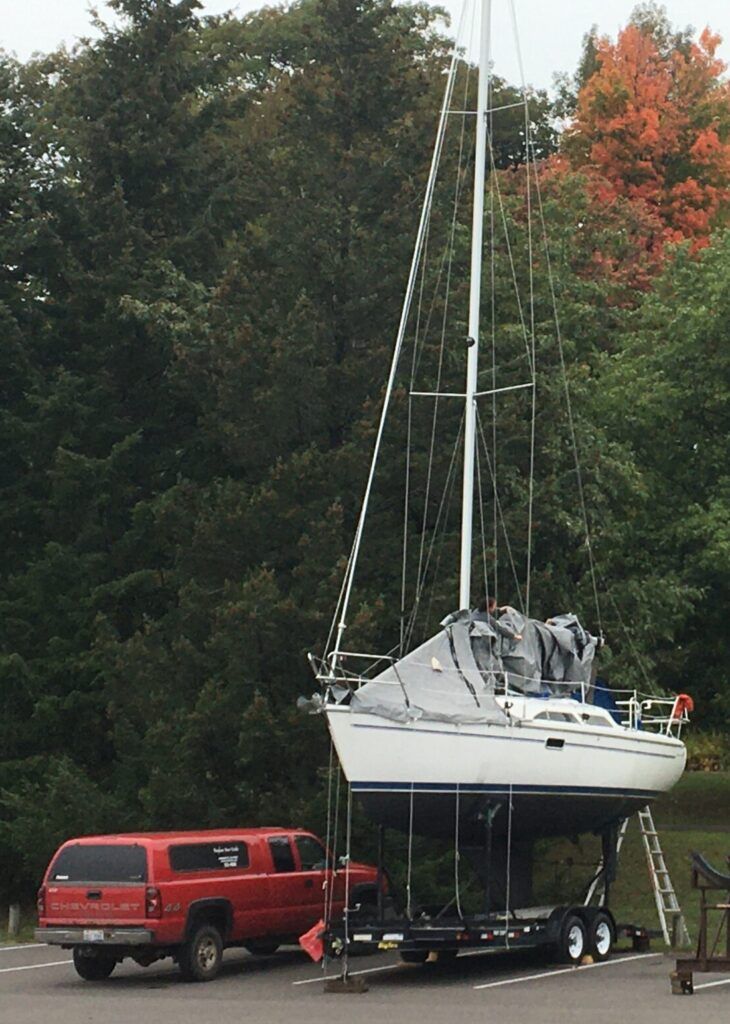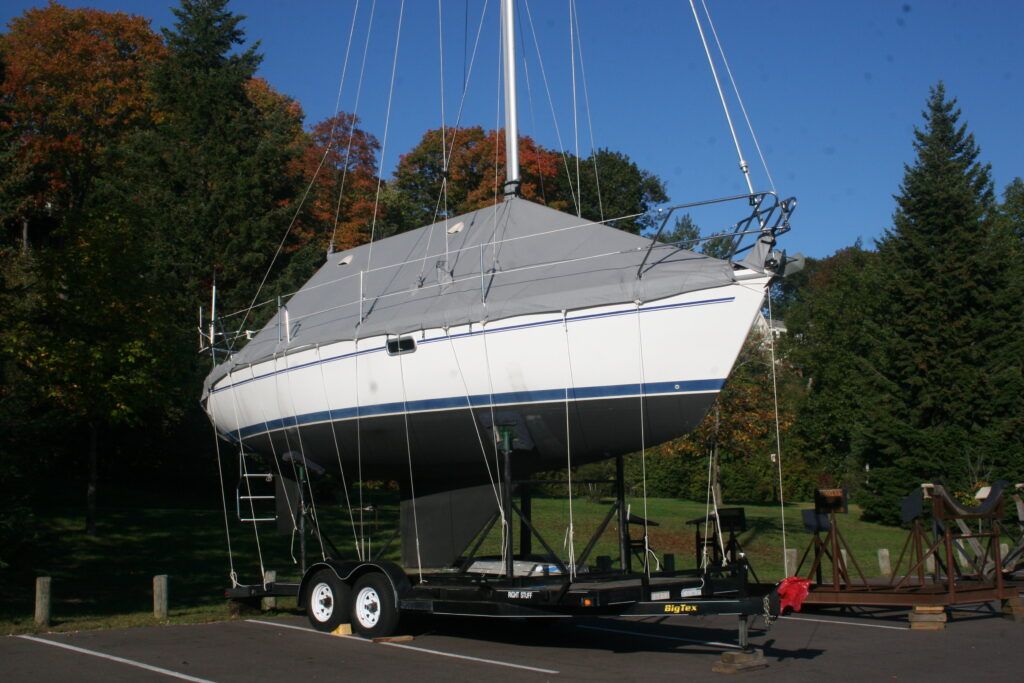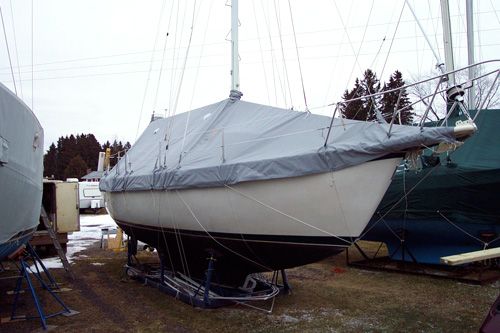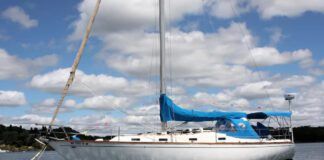The post-pandemic rush to the sea has brought a whole new group of readers into the Practical Sailor family, so although many of you are already solved your winter cover cunundrum and may remember this post from years past, I felt it was a good time to help those new readers who are facing their first winter on the hard.
The onset of winter in the northern hemisphere brings with it that age-old problem: How best to protect the boat from snow and ice? Already boats on Lake Superior are buttoned up, and sailors as far south as the Chesapeake have already settled in for winter. While many powerboats choose shrink-wrapping over a more permanent solution, sailboats-with their masts stepped or unstepped-are perfectly suited for reusable custom, or semi-custom covers.

The topic of winter covers is worthy of a larger article all it’s own. A few years ago, seeking a snapshot view of the custom-cover options, we talked to Jim Welinski, co-owner of the family-run Shipshape Canvas shop (www.shipshapecanvas.com) in Duluth, Minn., where stored boats face some of the country’s harshest winters.
Most custom covers today are frameless, making them easier to stow and install than the excellent DIY frame-cover described on our website. In either case, a reusable cover will save money in the long haul. A robust, frameless winter cover for a Catalina 30 costs about $2,000 and can last eight to 15 years (with a re-stitching after about eight years), depending on how you treat it. Lighter-weight covers for less-harsh climates sell for just under $1,500 and can last about eight years. A single-season shrinkwrap job will cost $850. You do the math.

For cold-weather covers in dark northern climates, Welinski likes Top Gun, an acrylic-coated polyester that is tough, low-stretch, mildew-resistant, and abrasion resistant, just what is needed to stand up to fierce wind and cold. The material has two cons: It has a tough industrial finish, so a softer material is used to prevent chafe where the cover meets the hull, and it is not breathable, so good vents are essential.
For sunny climates with milder winters, Welinski recommends the UV-stable synthetic blend Weathermax, a breathable fabric that helps prevent mildew and condensation, but is not as strong and abrasion-resistant as Top Gun. Coated acrylics like Sunbrella are another option. Although not as tough or abrasion-resistant as Weathermax (see PS sailcover test, December 2011), Sunbrella’s 10-year warranty (pro-rated) against UV damage tops Weathermaxs five years.

Welinski also recommends using the UV-resistant thread Tenera in sunny places. Some canvas makers charge extra for Tenera, which carries a lifetime warranty, but others like Sailorstailor (www.sailorstailor.com) use it in all their products. Tenera’s downside, Welinski said, is that it can allow water to seep through needle holes when sewn into Top Gun, making it less desirable in this application.
For maximum lifespan, the devil is in the details. (Welinski abhors metal grommets, notorious points of chafe.) We recommend using a reputable local canvas maker that will measure your boat and help you fit the cover properly. All it takes is one fierce winter storm to shred a poorly fitted cover. Proper rope tension is critical.
If no local option exists, look for a company that has already fitted your model boat or has a template on file. Insist the company make adjustments for free within the first year. A high-quality cover should carry a four to five-year warranty for workmanship on top of the warranty for materials.








































That’s really nice post. I appreciate your skills, Thanks for sharing.
It’s great that you talked about sailboat’s winter covers and which one adapts to your weather. My dad’s thinking about getting a boat. He’s always wanted one, but since we live in a place where the temperature during the winter goes crazy, he’s worried about how to keep it well covered. That’s why I think this article is going to help him be prepared for it. Thanks for the information on how for cold weather, it’s important to find a cover to stand up to the fierce wind and coldness.
The PO of my Bristol 35.5 purchased a frame and cover from Fairclough in CT in around 2000. I bought the boat in 2013, and by 2018 the cover needed to be replaced. I called Fairclough, they not only had the measurements, they still had the original purchase order! They quoted me around $1,600 for new canvas, since the frame is still fine.
Darrell, a very timely article with the link to the PS sailcover test of 2011 just as informative. I bought a two-piece canvas tarp from that “reputable local canvas maker” (he is) in 2007 that weathered 14 seasons with only minor rips and tears until this past winter when the aft piece tore laterally from side to side. I went cheap on the frames, making my own wooden supports, very amateurish but adequate. From what you say, I seem to have gotten a goodly number of seasons for the $1200 I paid back then. The tarp is currently in for repairs. Fingers crossed that it will cover my 27-ft, mast-up sloop for a few more years here under the heavy falls of snow off southern Georgian Bay.
My boat partner and I invested in a Fairclough custom cover (mast up) in 2008 for our 89’ Sabre 34 and although we’ve had several restitchings done through the years, I feel we made the right decision both economically and environmentally. Suggestions: Wrap foam pipe insulators around any and all possible chafing points using 3M Scotch #893 filament tape. Having a zippered door to use off season is a big plus as well as the vents for circulation.
Rarely seen now are waxed cotton canvas covers. I worked for decades at a yacht club in Toronto and there were some covers that were over 30 years old. They were heavy but ridiculously durable. The only thing that seemed to kill them was poor storage. If left lying on a cradle all summer they would rot but if stored dry indoors were fine.
We have a 2001 Catalina 42 which came with Top Flight cover. We replaced the cover with a new one from Top Flight, and had additions for storing with the mast up. We modified the rear to accommodate our new Tower in a Box, which required four new zippers and flaps to wrap around the tower.
So 17 seasons from the first cover, and the new one going on three. Beats having to buy plastic shrink wrap every year, and filling up our waste dumps with all that plastic, and at less expense. And Top Flight is very responsive when you need parts (new conduit or brackets) or to modify the existing cover for new things.
Here on Lake Erie we reuse shrink wrap I get 8yrs of use out of it Mast down with framework on a 42′ sailboat with 13.5′ beam. Some of powerboats are on 17 years of the same wrap a little tape goes along way.
I built a cover for my 43′ sloop using different color scrap strips of Sunbrella fabric. At the boatyard they call it the Circus tent. After the first season the wear points were pretty worn (Sunbrella doesn’t have much abrasion resistance.) I made wear patches from an old cut up dingy and they have held without any obvious wear for the next 3 seasons.
Thanks for this great article. I wrestled with this decision after buying my first sailboat in the summer of 2020 and realizing that I had to make a decision as winter approached and some leaky deck problems caused me to want to dry the boat out. I decided I wanted a full cover that would transmit some light, and allow me to work underneath all winter. I chose a system from Kover Klamps. I have not seen them mentioned in your articles. It is based on metal electrical conduit (EMT) and connectors. All told, it cost about $1600 for the frame and a tarp to go over it with a zip door, tie downs, and spares. I expect to get two or three years out of the tarp, and decades from the metal frame. It took a good bit of time to build the first time, and is not easy to move. But it is nice to work under during the winter, and allowed me to replace my two fixed and four opening portlights last winter. This year I will probably repair a piece of broken deck under a stanchion, and re-bed all of the other stanchions. In all, it has allowed me to work in relative comfort. It costs less than shrinkwrap and has less plastic waste. It costs and weighs less than canvas, and allows solar heating and lighting. I worry that it causes a lot of wind resistance due to how high I made it. It is scary to work under when the wind exceeds 25 knots!
Polyethylene plastic, standard sized tarps purchased over the counter and now online have covered my sailboats 23 – 33 ft for the past 40 years. For Upper Peninsula of Michigan and significant snow and wind, relative success with several tarps lasting five years tied over mast down and/or DIY wood frames. I recently purchased two 20’x16′ about $60 each for 16 mil.